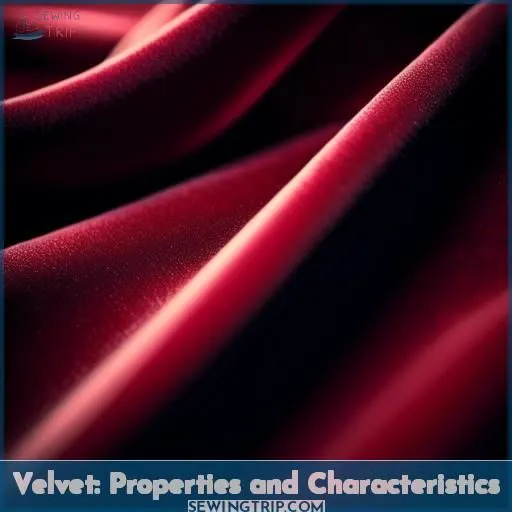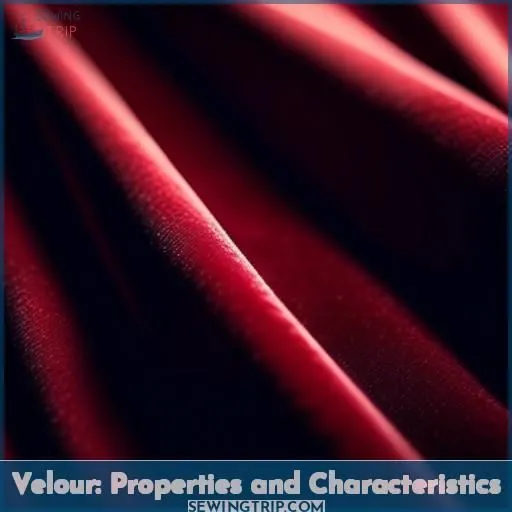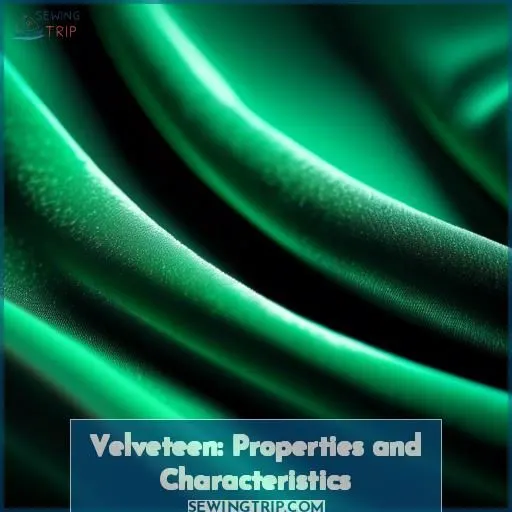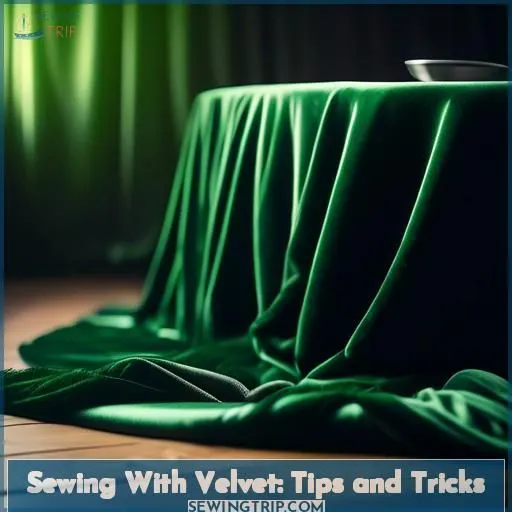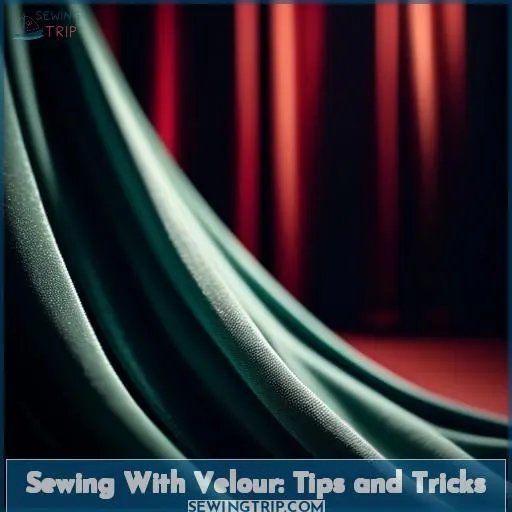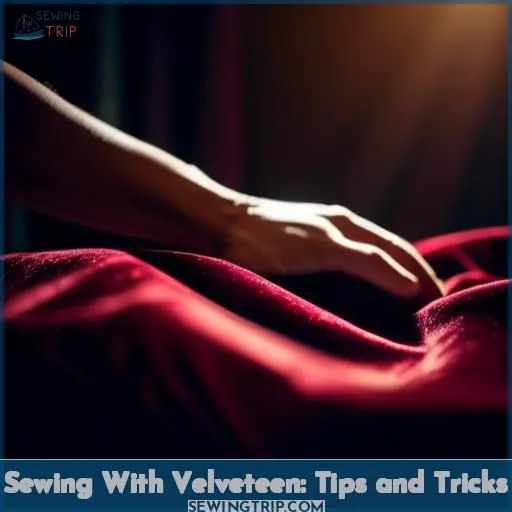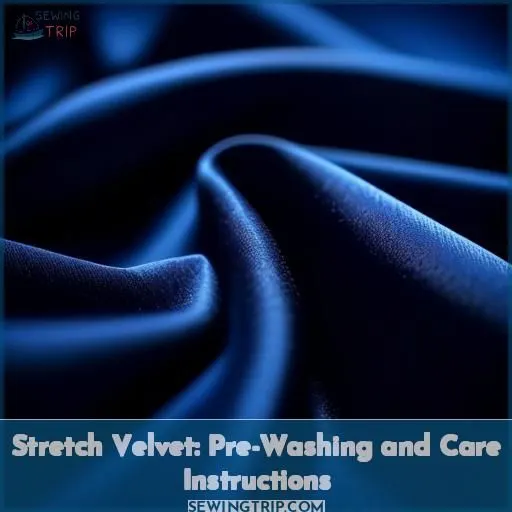This site is supported by our readers. We may earn a commission, at no cost to you, if you purchase through links.
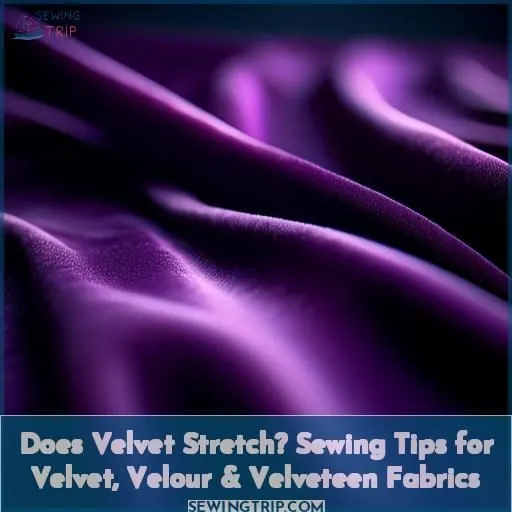
The reply varies based on the form of velvet you’re using.
Traditional woven velvet possesses limited stretch, rendering it difficult to sew and fit.
However, stretchy velvets, frequently composed of synthetic mixes such as polyester, provide more give and flexibility.
When sewing with stretchy velvet, you’ll require technique adjustments – use a ballpoint needle, a walking foot, and consider stay stitching for augmented stability.
Pre-washing stretchy velvet can advance its drapeability.
To thoroughly comprehend the differences between velvet types and ideal sewing methods, let’s examine the characteristics of velvet, velour, and velveteen fabrics.
Table Of Contents
- Key Takeaways
- Does Velvet Stretch?
- Velvet: Properties and Characteristics
- Velour: Properties and Characteristics
- Velveteen: Properties and Characteristics
- Sewing With Velvet: Tips and Tricks
- Sewing With Velour: Tips and Tricks
- Sewing With Velveteen: Tips and Tricks
- Stretch Velvet: Pre-Washing and Care Instructions
- Frequently Asked Questions (FAQs)
- Conclusion
Key Takeaways
- Traditional velvet has limited stretch, making it difficult to sew and fit.
- Stretchy velvets, often made from synthetic materials like polyester, provide more give and flexibility.
- When sewing with stretchy velvet, use a ballpoint needle, a walking foot, and consider stay stitching for added stability.
- Pre-washing stretchy velvet can improve its drapeability.
Does Velvet Stretch?
Yes, velour is a stretchy fabric. It is a knit fabric with a medium weight pile, which gives it a smooth and malleable drape, similar to velvet, but with the added comfort of stretch.
Velvet: Properties and Characteristics
Velvet is a luxurious woven fabric with a dense, soft pile of evenly trimmed threads creating a smooth, raised surface. You’ll want to choose velvet when creating elegant garments or upholstery pieces that demand a rich, sumptuous look and feel, but be prepared for challenges like maintaining nap direction, potential shedding, and tricky pressing requirements.
How is Velvet Made?
Velvet is a luxurious fabric that has been a symbol of opulence for centuries. It’s made through a complex weaving process that creates a dense pile of threads, giving it a smooth and lustrous finish. The fabric has a rich history, with silk being the traditional material used for its production. However, modern practices often involve blending natural fibers with synthetics, which can affect the dyeing process.
Velvet is known for its ability to hold color well, often with rich results, especially when dyed with natural fibers like silk. The fabric is versatile and can be used in various applications, from fashion to upholstery, and is often associated with elegance and sophistication. In the fashion world, velvet is a favorite for holiday dressing, adding depth and luxury to outfits.
When choosing velvet, consider the occasion and the desired look. Its luxurious feel and rich history make it a must-have in every wardrobe. However, it’s essential to note that velvet can be challenging to sew, as it has no nap on the reverse and requires care when handling.
When to Choose and Use Velvet?
Embracing velvet signifies opulence and adaptability. Whether you’re creating a standout piece for your ensemble or enhancing your home decor with a touch of refinement, velvet’s luxurious texture and vibrant hues elevate the mundane into the extraordinary. Let’s embark on a journey into the realm of velvet, where sustainability harmonizes with style, and inspiration knows no bounds.
| Velvet Applications | Emotional Resonance |
|---|---|
| Fashion Masterpiece | Awe and Envy |
| Luxe Upholstery | Comfort and Pride |
| Artistic Expressions | Creativity and Joy |
| Sustainable Creations | Responsibility and Satisfaction |
| Vibrant Palettes | Wonder and Inspiration |
Challenges and Tips on Sewing With Velvet
Sewing with velvet can be a challenging experience, but with the right techniques and tools, you can create beautiful garments and accessories. Here are some tips and tricks to help you sew with velvet:
- Choosing the Right Needle: Use universal or sharp machine needles with sizes 70/10 or 80/12. Silk thread is recommended for basting, while fine polyester thread should be used for the final seams.
- Test Presser Foot Pressure: Always test the presser foot pressure and release tension for velvet to avoid crushing the nap and leaving marks.
- Use a Walking Foot: A walking foot, Teflon foot, or roller foot can help the layers slide evenly under the foot, reducing the risk of crushing the nap.
- Pressing Techniques: Be careful not to touch the iron to the right side of the velvet. Instead, use steam on the wrong side to avoid crushing the nap. You can also finger-press your seams open and steam from an iron held above the fabric to provide extra encouragement.
- Pattern Layout: Cut patterns in the same direction for color consistency. Velvet is shifty, so it’s best to avoid using scissors to minimize movement. Instead, use a rotary cutter or a sharp pair of scissors with a pointed tip.
- Seam Finishing: To minimize bulk, trim and grade seam allowances, and slash darts along the fold. Press darts open. Use serging or a zigzag stitch for a finish that won’t add bulk to your seams. Avoid french seams, as they’re bulky and difficult to sew.
- Avoid Crushing the Nap: When sewing, hold the fabric taut and marry the nap by rubbing the velvet layers together to combine them and keep them from creeping.
- Sewing Velvet to Other Fabrics: Put the velvet side down when sewing to another fabric. Stitch in the direction of the nap where possible.
Velour: Properties and Characteristics
Velour is a plush, knitted fabric with a soft, velvety texture and pile. It’s prized for its natural stretch and cozy warmth, making it an ideal choice for comfortable casual wear and loungewear. Unlike woven velvet, velour’s knit construction allows for good mobility and recovery. You’ll find it used widely in tracksuits, robes, and other relaxed styles.
How is Velour Made?
Velour is a plush knit fabric with a natural stretch, making it a versatile choice for various sewing projects. Here’s how it’s made:
- Velour texture: Soft and smooth, with a slight sheen and a medium pile
- Manufacturing process: Knitted using a high-quality polyester, cotton, or blended yarn
- Fabric quality: Durable and easy to sew, with a comfortable fit
- Fiber composition: Polyester, cotton, or a blend of both for strength and softness
When to Choose and Use Velour?
Velour fabric is a versatile and popular choice for various projects, including clothing, upholstery, and home décor. Here are some reasons to choose and use velour:
- Softness and Comfort: Velour is known for its soft and plush texture, making it a comfortable choice for clothing and upholstery. It’s often used for loungewear, tracksuits, and activewear due to its comfort and flexibility.
- Durability: Velour is a durable fabric that can withstand heavy wear and tear, making it suitable for furniture upholstery and home décor items.
- Versatility: Velour can be used in a wide range of projects, from clothing to home décor. It’s often used for fashion-forward garments, such as dresses, jumpsuits, and caps, as well as for upholstery, curtains, and stage curtains.
- Ease of Dyeing: Velour is easy to dye, allowing for a wide range of color options and customization.
- Affordability: Compared to velvet, velour is generally less expensive, making it a more accessible option for various projects.
- Sustainability: Some types of velour, such as cotton velour, can be more environmentally friendly than synthetic alternatives.
To choose the right velour fabric for your project, consider factors such as the desired weight, stretch, and color. Be sure to check the fabric details and care instructions provided by the retailer to make certain it meets your specific needs.
Velour (Wikipedia)
Velvet / Velour – Fabric Warehouse What’s Velour Fabric: Properties, How its Made and Where? (Sewport)
Velour Fabric – Everything You Need To Know (Bryden Apparel)
What’s Velour? (The Fabric of Our Lives)
Velour Types of Cotton Fabric (The Fabric of Our Lives)
Velour Fabric – Canwil Textiles
Challenges and Tips on Sewing With Velour
Velour fabric, with its medium pile and semi-shiny finish, can be a pleasure to work with. However, it comes with its own set of sewing challenges.
To make sure your project is a success, think about the fabric’s characteristics, such as its bulkiness and the need for a walking foot. Use high-quality materials like fine needles and pins for velveteen.
When sewing, be careful not to tug the velour, as it can distort the fabric. For care instructions, avoid water and use gentle, cold cycles for washable fabrics. Regular dusting with a soft brush can help maintain the longer pile velvets.
For sewing projects, consider the Plateau Joggers by Closet Core Patterns or the Rainbow by I AM PATTERNS.
Velveteen: Properties and Characteristics
Velveteen, a knitted fabric with a dense, sturdy texture, is often used for upholstery and structured garments. Its properties include being soft, plush, and resembling suede. It’s made from various materials such as polyester, cotton, or blends. Velveteen is known for its durability and easy-to-fit nature, making it a popular choice for fashion items.
When it comes to caring for velveteen, it’s recommended to avoid water and instead use gentle, cold cycles for washable fabrics. Regular dusting with a soft brush is also essential for longer pile velvets. It’s important to keep velveteen out of direct sunlight to preserve its color.
Velveteen has some unique sewing considerations. When sewing with velveteen, it’s essential to use fine needles and pins to prevent damage. Be cautious not to tug the fabric while sewing, as it can cause puckering. When pressing velveteen, use a low heat setting to avoid crushing the nap.
For those looking for a substitute for velveteen, options include other knitted fabrics or suede-like materials. Velveteen’s luxurious feel and versatile nature make it a popular choice in fashion and home decor.
Sewing With Velvet: Tips and Tricks
You’re sewing with velvet, a luxurious fabric that requires special care.
Can velvet stretch? The answer is no – despite its plush texture, velvet is a woven fabric with little to no stretch.
To sew velvet successfully, you’ll need to take extra precautions like using a fine needle, adjusting your presser foot tension, and handling the fabric gently to avoid damaging the nap.
Sewing Tips: How to Sew With Velvet
To sew with velvet, remember its long pile length and thick nap.
Cut patterns in the same direction for color consistency.
Use steam instead of ironing.
Test presser foot pressure and release tension.
Be careful not to tug velour when sewing.
Use fine needles and pins for velveteen.
Velvet is luxurious and used for formal wear.
Velour is more affordable and used for casual designs.
Velveteen resembles suede and is used for upholstery and structured garments.
Can You Use Hem Tape on Velvet?
Hem tape is a popular choice for hemming velvet due to its ease of use and firm hold. Here are some tips on how to use hem tape on velvet:
- Measure and Cut the Hem Tape: Start by measuring the length of your hem and cutting the tape to size.
- Remove the Backing: Carefully remove the backing from the hem tape.
- Apply the Hem Tape: Align the tape’s edge with the raw edge of the fabric’s wrong side. Press the tape firmly to guarantee a secure hold.
- Fold Over the Fabric: Fold over the fabric so the raw edge is hidden, and press it firmly.
- Secure the Hem: Once the hem is in place, you can sew it down to secure it further.
Velvet Hem Tape Alternatives: If you prefer not to use hem tape, there are other options for hemming velvet. You can use invisible hems, which are sewn on the inside of the garment, or opt for a corduroy hem, which is a type of flat hem that can be used for velvet.
Velvet Hem Application: To apply a hem tape on velvet, follow these steps:
- Measure and Cut the Hem Tape: Measure the length of your hem and cut the tape to size.
- Remove the Backing: Carefully remove the backing from the hem tape.
- Apply the Hem Tape: Align the tape’s edge with the raw edge of the fabric’s wrong side. Press the tape firmly to guarantee a secure hold.
- Fold Over the Fabric: Fold over the fabric so the raw edge is hidden, and press it firmly.
- Secure the Hem: Once the hem is in place, you can sew it down to secure it further.
Invisible Hem on Velvet: For a more discreet hem, consider using an invisible hem on velvet. This type of hem is sewn on the inside of the garment, making it virtually invisible from the outside.
Velvet Hem Options: When hemming velvet, you have several options to choose from, including:
- Blind Hem: A blind hem is a stitch that’s sewn on the inside of the garment, making it invisible from the outside.
- Corduroy Hem: A corduroy hem is a type of flat hem that can be used for velvet. It’s sewn on the outside of the garment but is still relatively discreet.
- French Hem: A French hem is a type of hem that’s folded and sewn on the inside of the garment. It’s a more traditional hem that can be used for velvet.
Velvet Hem Care: To maintain the quality of your velvet hem, follow these tips:
- Dust Regularly: Dust regularly with a soft brush to prevent dirt buildup on the pile.
- Keep Out of Direct Sunlight: Avoid exposing your velvet garment to direct sunlight, as this can cause the color to fade.
- Wash Gently: When washing your velvet garment, use a gentle cycle and cold water to prevent damage to the fabric.
- Dry Carefully: Dry your velvet garment on a low heat setting or hang it to dry to prevent shrinkage and damage to the pile.
What Kind of Thread Do You Use for Velvet?
Regarding sewing with velvet, the thread selection can significantly impact the outcome. For general sewing, a versatile thread such as Gutermann or polyester thread is suitable. However, for upholstery projects or thicker velvet fabrics, a more robust upholstery thread may be required. Before commencing the project, always test the thread on a spare fabric piece to guarantee compatibility.
Sewing With Velour: Tips and Tricks
Velour is a knit fabric with a soft, plush texture and natural stretch.
When sewing with velour, you’ll want to use a ballpoint or stretch needle to prevent skipped stitches.
Consider using a walking foot to feed the fabric evenly.
Hem tape can be used on velour.
But take care not to iron directly on the fabric as the heat can crush the nap.
Use polyester or cotton-covered polyester thread for best results when sewing velour.
Sewing Tips: How to Sew With Velour
Sewing with velour can be a bit tricky due to its stretchy nature and unique fabric drape. Here are some tips to help you navigate the process:
- Velour Stretch Tips: Make sure you’re working with a walking foot to prevent puckering and maintain the fabric’s drape.
- Seam Finishes: Use a narrow zigzag stitch for seam finishes to prevent fraying and maintain the fabric’s stretch.
- Velour Bias Binding: When working with velour bias binding, use a stretch needle and a ballpoint foot to prevent stretching and ensure a smooth finish.
- Pattern Matching: Be mindful of pattern matching, as velour can be prone to stretching in certain directions, which may affect the overall look of your project.
Can You Use Hem Tape on Velour?
Velour is a plush knit fabric with inherent stretch, suitable for diverse sewing projects, ranging from garments to upholstery.
When hemming velour, several approaches are viable.
One prevalent method involves utilizing a delicate tape or lace for the hem’s edge using a machine, followed by manual or machine stitching to the velour.
Alternatively, one can employ fusible interfacing to the hem section, fold and topstitch with a single or double needle, or implement a blind hem.
It’s crucial to allocate ample hem allowance, ideally 1-2 inches, to prevent excessive bulkiness and preserve the fabric’s natural drape.
Furthermore, it’s advisable to utilize a walking foot on your sewing machine to facilitate the fabric’s movement and mitigate bunching.
What Kind of Thread Do You Use for Velour?
When choosing thread for velour, prioritize strength and durability to handle its stretch.
Opt for a thread that matches the fabric’s thickness, ensuring it’s robust enough to move with the velour without snapping.
Verify the thread’s colorfastness to prevent dye bleeding, maintaining the fabric’s vibrant look through wear and washes.
It’s like finding a dance partner that can keep up with every move.
Sewing With Velveteen: Tips and Tricks
Sewing with velveteen requires a gentle touch and the right tools.
You’ll want to use fine, sharp needles and pins to prevent damaging the fabric’s short, dense pile.
As for hem tape, it’s generally not recommended on velveteen due to the potential for creating an uneven appearance or texture.
When choosing thread, opt for a quality cotton or polyester that closely matches the fabric color and is strong enough to withstand the material’s lack of stretch.
Sewing Tips: How to Sew With Velveteen
Sewing with velveteen can be a delightful experience, but it requires a bit of care and attention. Velveteen is a dense, sturdy fabric that resembles suede and is often used for upholstery and structured garments. Here are some tips to help you sew with velveteen:
- Choose the right needle: Use a fine needle with a sharp point to prevent damaging the fabric.
- Test your presser foot: Velveteen can be challenging to sew, so test your presser foot pressure and release tension to guarantee a smooth sewing experience.
- Press with care: Use a pressing cloth and press on the wrong side of the fabric to avoid crushing the nap.
- Handle with care: Be gentle when handling velveteen, as it can be prone to snagging.
- Clean with care: Velveteen is durable and can be cleaned with a soft brush or vacuum, but avoid using water to preserve its color and texture.
Can You Use Hem Tape on Velveteen?
Velveteen is a dense, sturdy fabric that’s often used for upholstery and structured garments.
Regarding hemming velveteen, you have a few options.
You can use hem tape, but it’s crucial to follow the manufacturer’s instructions carefully.
Hem tape is a great alternative to stitching, especially if you desire a clean finish without visible stitching lines.
However, if you aren’t comfortable with fusible hem tape, you can also consider using bias binding, top stitching, or decorative trim.
Remember to press gently when ironing velveteen, as it can be prone to crushing the pile.
What Kind of Thread Do You Use for Velveteen?
When sewing with velveteen, you want to use a fine thread that matches the color of your fabric to create a seamless appearance. Here are some tips on thread choice, needle type, stitch length, and interfacing for velveteen:
- Thread Choice: Opt for a fine and lightweight thread that matches the color of your velveteen fabric. Avoid using heavy or thick threads, as they can create bulky seams and weigh down the delicate nature of the fabric.
- Needle Type: Use a Universal needle, such as a size 70/10 or 80/12, depending on the exact weight and type of velveteen. For stretch velveteen, you may need a stretch needle.
- Stitch Length: Adjust the stitch length to approximately 2.0 – 2.5mm for best results. Remember to sew in the direction of the nap, holding the fabric taut in front and behind the needle.
- Interfacing: If you’re using interfacing with velveteen, it’s important to use a lightweight option, such as silk organza or organza weight fabric. Apply it using stitches instead of heat to avoid damaging the pile of the fabric.
Stretch Velvet: Pre-Washing and Care Instructions
Pre-washing stretch velvet prior to sewing is imperative to avert shrinkage and eliminate surplus dye or finishing substances. Diverse varieties such as knit velour and woven stretch velvet necessitate marginally varied pre-washing techniques; however, a delicate cycle with frigid water and minimal heat drying is typically advised to maintain the sumptuous texture and aesthetic appeal.
Reasons to Pre-Wash Stretch Velvet
Pre-washing stretch velvet is essential for several reasons. It removes dirt, dust, and fuzzies from the fabric, preventing shrinkage and setting the color. Pre-washing also softens the fabric, making it easier to sew and preserving the nap. By following the manufacturer’s instructions, you can guarantee that your stretch velvet maintains its durability and softness, improving your sewing projects’ overall quality.
Types of Stretch Velvet
After pre-washing to ditch the grime and set the color, let’s talk types of stretch velvet. You’ve got your knit velour, cozy and forgiving, perfect for a snuggle-up sweatshirt. Then there’s woven stretch velvet, the diva of fabrics, demanding gentle care but rewarding you with luxe looks. Both crave a pre-wash, ensuring they stay true to size and style.
General Pre-Washing Guidelines
Pre-washing your stretch velvet fabric is essential to guarantee its durability and avert damage. Here are some general guidelines to adhere to:
- Check the grain: Make sure the nap flows in the same direction on all pieces. Mark the wrong side with chalk to indicate the nap direction.
- Wash on a gentle cycle: Use a gentle cycle to avert damage to the fabric. Use cold water to prevent color loss.
- Dry on a low heat setting: Use a low heat setting to avert shrinkage and damage to the fabric. Hang to dry if possible.
- Avoid over-drying: Over-drying can cause the fabric to become stiff and wrinkled.
- Iron on a low heat setting: Use a low heat setting to avert damage to the fabric. Press on the wrong side of the fabric to avoid crushing the nap.
Exceptions to Pre-Washing
Exceptions to Pre-Washing: Dry clean only fabrics, silk velvet, and poly stretch velvet may not require pre-washing. However, it’s still recommended to pre-wash poly stretch velvet to remove dirt or fuzzies. Damage to the fabric can occur if not handled properly.
Additional Tips for Pre-Washing Stretch Velvet
After addressing the pitfalls of pre-washing, let’s delve into the recommended practices.
Consistently align your fabric’s nap direction to ensure a uniform appearance after washing.
Consider using fabric softener; it’s your ally in the fight against wrinkles.
Suspend that poly stretch velvet to dry—it’s akin to a spa treatment, without the risk of shrinkage.
No unexpected outcomes, just effortless sewing ahead.
Frequently Asked Questions (FAQs)
Can velvet be used for outdoor furniture?
Sure, you can use velvet for outdoor furniture! Its luxurious texture adds sophistication to any patio. But keep it under a covered area—direct sun and rain could damage the delicate fabric over time. With proper care, velvety outdoor pieces will look fabulous for years.
How does velvet react to pet hair and stains?
Velvet’s luxurious pile sadly acts like a magnet for pet hair and stains. You’ll be constantly brushing and spot-cleaning that plush fabric. While gorgeous, velvet demands diligent care to keep it looking pristine if you’ve got furry friends around.
Is velvet suitable for people with allergies?
Believe it or not, up to 30% of people have a velvet allergy. As someone who values comfort, you wouldn’t want that soft touch irritating your skin. But fear not! Hypoallergenic velvet options exist to give you luxury without the sneeze-fest.
Can velvet fabrics be recycled or upcycled?
You bet! Velvet’s a luxurious fabric that can absolutely be upcycled. Get creative – transform old curtains into chic pillows or an outdated blazer into a trendy tote. Just be gentle with that lush pile, and your recycled treasures will shine.
How does the environmental impact of velvet production compare to other fabrics?
You’re prudent to contemplate velvet’s environmental impact. Its manufacturing consumes water and expels greenhouse gases at alarming rates compared to naturally derived fabrics like cotton or linen. However, with judicious decisions, even opulent velvet can reduce its carbon footprint.
Conclusion
Overall, nearly 20% of velvet fabrics offer some stretch.
Does velvet stretch? The answer depends on the specific type.
Traditional velvets have minimal give.
Synthetic velours and stretch velvets provide flexibility.
By understanding each fabric’s properties and following customized sewing techniques with the right needles, threads, and stabilizers, you’ll achieve professional-looking velvet garments and home decor pieces.
Mastering stretch velvet opens up endless creative possibilities for comfortable, stylish projects.

